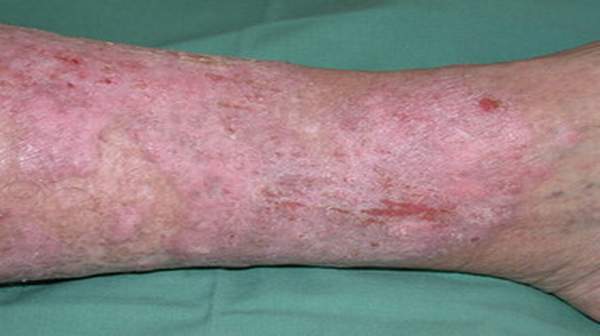What's in this article?
Varicose eczema is a skin condition caused by increased pressure in the veins of the legs. It usually affects older people. It often takes a long time to heal. Moisturisers (emollients), steroid ointments and compression stockings are the common treatments.
Varicose eczema is a long-term skin condition that affects the lower legs and is common in people with varicose veins.
It is also known as venous eczema, gravitational eczema and stasis eczema.
What causes venous eczema?
Venous eczema appears to be due to fluid collecting in the tissues and activation of the innate immune response.
Normally during walking the leg muscles pump blood upwards and valves in the veins prevent pooling. A clot in the deep leg veins (deep venous thrombosis or DVT) or varicose veins may damage the valves. As a result back pressure develops and fluid collects in the tissues. An inflammatory reaction occurs.
Who gets venous eczema?
Venous eczema is most often seen in middle-aged and elderly patients—it is reported to affect 20% of those over 70 years. It is associated with:
- History of deep venous thrombosis in affected limb
- History of cellulitis in affected limb
- Chronic swelling of lower leg, aggravated by hot weather and prolonged standing
- Varicose veins
- Venous leg ulcers
What are the symptoms of Varicose Eczema (Stasis Dermatitis)?
Symptoms of eczema may include itching, which is the most common symptom, dry skin and rash usually consisting of red or scaly areas of skin.
Areas infants are commonly affected by eczema are face, neck, extensor surfaces, trunk and groin. In children front of elbows and behind the knees and in adults the front of elbows, behind knees, face, neck and upper chest are most affected.
More symptoms can occur that include rash may develop oozing or crusting of the skin, thickening and leathery quality of skin with chronic eczema (known as lichen simplex chronicus), paleness around the mouth, extra fold of skin beneath lower eyelid (Dennie’s or Morgan’s line) and/or increased number of skin creases on the palms.
The cracks and poor skin condition of this disorder predisposes for the entry of bacterial infection causing spreading cellulitis infection in the leg. If the skin condition deteriorates further and breaks down, a venous ulcer (also known as statis ulcer) may form.
Immediate medical attention is recommended if redness and swelling occur, a yellowish crusting is present or drainage of pus is observed.
How can varicose eczema be prevented?
There are a number of things you can do yourself to prevent varicose eczema from occurring/reoccurring:
- Look after your legs extra care and attention to your legs is needed for the rest of your life.
- Lose weight if necessary.
- Varicose veins can be treated, so consult your doctor if you think you have them. Although unfortunately, in some regions, varicose vein surgery or laser treatment is not available on the NHS.
- If you have varicose veins, your leg veins should be supported at all times. For mild cases which require low‐strength compression, elastic support stockings or tights, available from most pharmacies, are adequate. For more severe varicose veins, compression hosiery is made to measure and can be prescribed by your doctor or nurse.
- If you have a venous ulcer, you will need compression bandages, which will be applied by a nurse, when your leg ulcer is dressed.
- Always put any compression hosiery on before you get out of bed in the morning before any fluid can build up in your ankles.
- Try not to stand still for a long time. If you have to, then frequently flex your feet or bend down at the knees. This will help to keep blood moving in the veins. Sitting is better than standing still, especially if you can sit with your feet up.
- Exercise is important a brisk walk twice a day or walking up stairs, can make your leg muscles work and help push blood through their veins.
How varicose eczema is treated
Varicose eczema tends to be a long-term problem. However, treatments are available to help keep it under control.
For most people, treatment involves a combination of:
- self-help measures – including ways to improve your circulation, such as keeping active and frequently raising your legs
- emollients – moisturisers applied to the skin to stop it becoming dry)
- topical corticosteroids – ointments and creams applied to the skin to help treat the eczema and relieve symptoms
- compression stockings – specially designed stockings, usually worn every day, that steadily squeeze your legs and help to improve your circulation
If these treatments don’t help, your GP may refer you to a dermatologist (skin specialist) in case there is another cause for your symptoms or if they are concerned you may also have a type of eczema called contact dermatitis.
If you also have varicose veins, you may be referred to a vascular specialist (a doctor or surgeon specialising in conditions affecting the blood vessels) who can talk to you about the treatment options for varicose veins.
Read more about treating varicose eczema.








